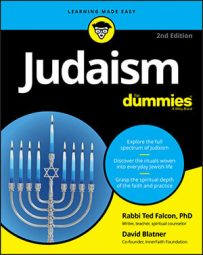The Jewish calendar isn't just a tool for observing the passage of time. Judaism marks and celebrates time in a number of ways — holidays, Shabbat, the weekly readings of specific portions of the Torah, and the rituals of the personal life cycle.
Months and years in the Jewish calendar
The Jewish calendar, unlike the civil Gregorian calendar, is based both on the cycles of the moon as well as the sun — the months correspond to cycles of the moon and the years correspond to cycles of the sun. Since a lunar month has about 29-1/2 days, Jewish months always have either 29 or 30 days. The problem is that 12 lunar months is 10-1/2 days short of the 365-day solar year.
In the fourth century, Rabbi Hillel II instituted a mathematical system of rectifying the lunar and solar years which is still used today: The years are divided into 19-year cycles, seven of which are leap years that have 13 months instead of 12. (The details of Hillel's calculations are mind-bogglingly dense.)
The 12 Hebrew months are called Nisan, Iyar, Sivan, Tamuz, Av, Elul, Tishrei, Heshvan, Kislev, Tevet, Shvat, and Adar. On leap years, Adar is followed by a month called Adar 2. If your birthday falls in Adar 2, it's celebrated in Adar on non-leap years.
The years of the Hebrew calendar are always 3,760 or 3,761 years greater than the Gregorian calendar that most people use. For example, the year 2020 will be the Hebrew years 5780 to 5781 (the discrepancy is because the Hebrew year number changes at Rosh Hashanah, in the fall, rather than on January 1). The calendar is so far ahead because the Jewish calendar is calculated from the creation of the world. Sometime between the ninth and twelfth century CE (Common Era), rabbinic scholars decided — based on tradition and biblical interpretation — that Creation happened in 3761 BC (on October 7 of that year, to be exact).
Double-day celebrations in the Jewish calendar
In the Jewish calendar, the first of the month always falls on the new moon, and the fifteenth of the month is always a full moon. However, in the ancient days, before science figured out how to predict the new moon, the declaration of a new month came from authorities in Israel (based on the reports by witnesses). But later, rabbis realized that it might take too long to get word from Israel to Jews around the world about when the months began. So a rabbinical decision was made that all holidays (except Yom Kippur) would be observed for an extra day for Jews living outside Israel, just in case the days were counted incorrectly.
Days in the Jewish calendar always begin at sunset. The holidays in the following table all begin at sundown the day before the date listed.
| 2013-2014/5774 | 2014-2015/5775 | 2015-2016/5776 | 2016-2017/5777 | |
|---|---|---|---|---|
| Rosh Hashanah | Sept. 5 | Sept. 25 | Sept. 14 | Oct. 3 |
| Yom Kippur | Sept. 14 | Sept. 26 | Sept. 23 | Oct. 12 |
| Sukkot | Sept. 19 | Oct. 9 | Sept. 28 | Oct. 17 |
| Hanukkah | Nov. 25 | Dec. 17 | Dec. 7 | Dec. 25 |
| Tu B'Shvat | Jan. 16 | Feb. 4 | Jan. 25 | Feb. 5 |
| Purim | March 16 | March 5 | March 24 | March 12 |
| Passover | April 15 | April 4 | April 23 | April 11 |
| Shavuot | June 4 | May 25 | June 12 | May 31 |
| Tishah B'av | Aug. 5 | July 26 | Aug. 14 | Aug. 1 |

